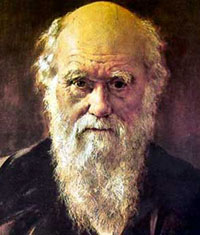 |
Had Darwin known of the clotting mechanism that took place when he cut himself, no doubt he would have been faced with another terrible dilemma for his theory. Present-day Darwinists are well aware of this. Yet the way that they still support the theory shows that Darwinism is not a theory as much as an ideology developed in opposition to belief in God and the fact of creation. |
When Charles Darwin was climbing the rocks of Galapagos Islands—pursuing the finches that would eventually bear his name—he must have cut his finger occasionally or scraped a knee. Young adventurer that he was, he probably paid no attention to the little stream of blood trickling out. Pain was a fact of life to the intrepid island explorer, and it had to be borne patiently if any work were to get done.
Eventually the blood would have stopped flowing, and the cut would have healed. If Darwin noticed, it would not have done him much good to speculate about what was going on. He didn't have enough information to even guess at the underlying mechanism of clot formation; the discovery of life lay more than a century in the future.61
For an evolutionist, a great many things in nature cannot be explained. If a mechanism is too complex to have come into being spontaneously, and if all its component parts must be present in order for it to be able to function, then this is sufficient evidence to entirely invalidate the theory supported by the evolutionist in question. Throughout their lives, evolutionists—Darwin included—have encountered a great many mechanisms of irreducible complexity. Perhaps one of the most important of these phenomenon is the blood clotting or coagulation, which takes place in an entirely natural manner in our bodies.
Darwin wrote that the thought of the human eye gave him chills because of its extraordinary complexity. But there were many other complex systems besides the eye, including blood coagulation which he did not know about in his day. As Professor Michael Behe stated, had Darwin known by what stages blood coagulation came about when he cut his hand, no doubt this would have represented another insoluble dilemma for his theory. In our time, some evolutionists do see this important fact and witness the phases of this extraordinary mechanism in their laboratories. However, despite this miraculous phenomenon, of which not even a single phase can be explained in terms of evolution, the theory still has its proponents, once again proving that this ideology of Darwinism is a dogma developed against religion, and put forward to deny the fact of creation.
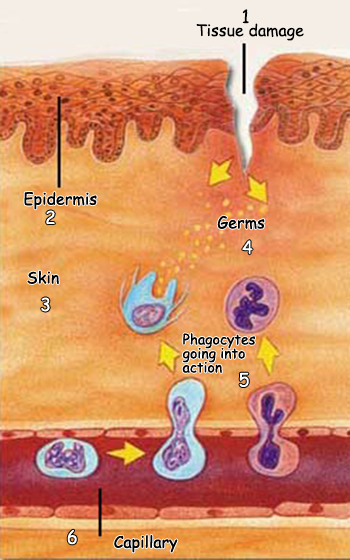 | |
1. Tissue damage | 4. Germs |
When you cut yourself, some 40 different substances responsible for coagulation go into action. Within seconds, all the nerves and repair systems in your body have been stimulated. We are once again seeing a perfect control mechanism created in our bodies by God. | |
Pour a quantity of liquid in a container and then make a hole in the bottom. No matter what the liquid may be, it will begin pouring out of the hole, and will continue doing so until the container is empty. You need to close the hole in some way; otherwise you cannot halt the flow. The only liquid on Earth capable of closing up a hole by itself, by spreading a microscopic net over it, is blood. Even more miraculously, the blood that does this is moving at an exceptional relative speed.
When you cut yourself, you may be unaware of the processes that take place at the site. You are sure that the blood will soon stop flowing in minutes and that the cut will heal and disappear within a few weeks. There is no need for you to do anything to staunch the flow and heal a small wound. Indeed, if the blood did not do this itself there is no way that you could stop it flowing and heal the cut. Whatever you do, you cannot prevent the blood flowing. In order to do so, you need the factors that cause the blood to coagulate. So what are these factors?
More than 40 substances cause clotting in the blood and tissues. Some of these initiate clotting, others accelerate it, and still others cause it to come to an end. In the body, clotting depends on a balance between the factors that accelerate coagulation and those that prevent it. Under normal circumstances, there should be more factors that prevent clotting than there are accelerating it. Thus there can be no question of uncontrolled coagulation taking place in the body. The moment that more accelerating factors than decelerating ones occur, a vein may be damaged.62
When a vein is damaged, rather intense activity begins in the body. A few seconds later, all the nerves and repair systems in the body have been stimulated. As we saw earlier in discussing thrombocytes, the clotting mechanisms reduce the amount of blood being lost. Chemical substances released at the wound site activate the white blood cells against any infection. If the wound is a large one, then the brain enters a state of alarm, seek to regulate the body's impaired functions by having glands secrete chemical substances and a whole array of hormones into the blood. This is an extraordinary control mechanism created in the body by God.
Both the taking of intense precautions in the event of serious damage and the beginning of the clotting process need to take place at once. In order for this to happen, an extraordinarily rapid communication system is essential. It takes only 50 milliseconds—a really dizzying speed—for nerves to send the brain information about the extent of the wound. The person concerned will often be unaware that a cut has occurred on the skin surface.
But if the bleeding is not stopped, then falling blood pressure and the reduction in the fluid level will damage all organs in the body, especially the brain. When brain functions slow due to loss of blood, first faintness occurs, followed in around 30 seconds by loss of consciousness. Then the kidneys, which function under normal blood pressure, will be unable to operate properly as a result of falling blood pressure. It is therefore vital that the blood flow be stopped at once.
The first steps are vital. Two seconds after a vein is ruptured, its wall contracts with a sudden spasm—a reflex, in other words. Arteries, which have thick walls, take other precautions and automatically close, thus reducing the blood flow to a minimum. The spasm is to the same extent as the bleeding in the veins. The reflex action in question may last for 20 to 30 minutes. Following this precaution, the thrombocytes enter the equation. Thrombocyte clot begins to develop in 10 to 15 seconds if the bleeding is severe, and in 1 to 2 minutes if minor. To a large extent, bleeding is halted.63
The wound now needs to close up completely, and the bodily functions must continue as before. The coagulation mechanism therefore now goes into operation.
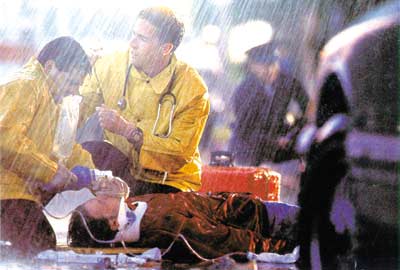 |
Stopping any bleeding in the body is of the greatest importance. If bleeding is not halted, then vital organs such as the brain and kidneys will suffer damage due to reduced blood pressure and fluid loss. But when you damage a vein, the factors that comprise this extraordinary clotting network go right to work. |
In a single book, it's impossible to examine in detail the 40 factors that influence coagulation in the blood. Therefore, it will be appropriate to introduce only the system's main elements. On the subject of plasma, it was stated that fibrinogen was one of the proteins contained in it. Fibrinogen is one of the most important elements of the coagulation process, and is the stable state of the blood-clotting material. Fibrinogen dissolves in plasma in the same way that salt dissolves in water. It continues to float in solution until a wound occurs anywhere in the body.
When a wound does occur, a protein enzyme known as thrombin breaks two of the three links in the fibrinogen chain. This protein is now converted to fibrin, and is now in an active state. The severed fibrin surfaces possess adhesive sections, which cause other fibrins to approach and bind to them. This mass brought into being by fibrins sticking to one another is the primary clot produced to halt the bleeding. In the first phase, the first clot forms without too much detailed work. The objective here is to halt the blood, and also to perform first aid using as little protein as possible—in other words, to economize on protein.
Thrombin, which goes into action straightaway with the opening of a wound in the body, begins cutting all the fibrinogen links it finds. However, thrombin must not do this constantly or in any other location than that of the wound. If it acted independently in that way, then all the fibrins it severed would stick to one another, and uncontrolled clotting would take place in the bloodstream, leading to the veins becoming blocked. That being so, the thrombin has to be kept under tight control and instructed to act in the right place and at the right time.
At this stage, another connection proving the mechanism's irreducible complexity appears: another protein that sets thrombin in motion, known as Stuart factor. It severs the prothrombin in the blood plasma and turns it into active thrombin. However, if the Stuart factor were to turn every prothrombin it encountered into thrombin aimlessly, then the result would again be uncontrolled activity and the likelihood of clotting in the bloodstream. Therefore, Stuart factor must not be in a constantly active state in the bloodstream, but must await an order to go into action.
 |
When damage occurs in a vein (A) the particles known as thrombocytes (B) release chemicals that initiate a string of reactions in order to prevent blood loss. One of these reactions is the production of fibrin, which forms a network that blocks the way for blood cells and plasma (C). Thus an emergency measure is taken to prevent blood loss. |
The command for Stuart factor to begin working comes from a protein called accelerin. However, accelerin is a neutral protein floating in the blood that has to be activated, and of course, a protein is needed to do this. Yet most surprisingly, the protein thrombin allows the accelerin to be activated, even though, as you'll remember,thrombin comes after accelerin in this sequence. So how does such an event take place?
A precautionary measure has been taken in the body to that end. Under normal conditions, a quantity of thrombin is always present in the blood. It is therefore the already present thrombin molecules that initiate this activity. Nonetheless, however, the way that these consecutive activations happen—and especially how the thrombin is set in motion—is not yet fully understood.64
In the stages described so far, the important thing is the extraordinary complexity of this incomparable system in the body. Furthermore, there are a great many other proteins and enzymes that have not been described in detail. Considering that there are 16 different enzymes producing thrombin alone, clearly the removal of a single enzyme in these phases will bring the entire system to a halt.65 For example, if the Stuart factor does not convert the prothrombin into thrombin, then the thrombin will quietly pass by the fibrinogen, and the wounded individual will probably die from loss of blood. The activated, the activators and the elements that enable clotting to take place must all be present at the same time. This is irreducible complexity, from which not a single component can be removed.
After these descriptions, you can better understand the difficulty facing Darwinists. According to the theory of evolution, one of the countless proteins involved must inevitably have come into being first, and the others must later have come into being consecutively, over periods of time. However, no living organism can afford such a long waiting period. So long as the system is imperfect, intermediate stages will serve no purpose—for which reason there can actually be no such intermediate stages. Indubitably, this impressive system came into being and began functioning at once, with all its systems, enzymes and mechanisms. It is Almighty God Who creates this system with all its magnificent features and complexity. He has created the heavens and Earth, and reveals His wisdom in every entity He creates. This is the truth that Darwinists are unwilling to accept.
What Happens When You Bleed? |
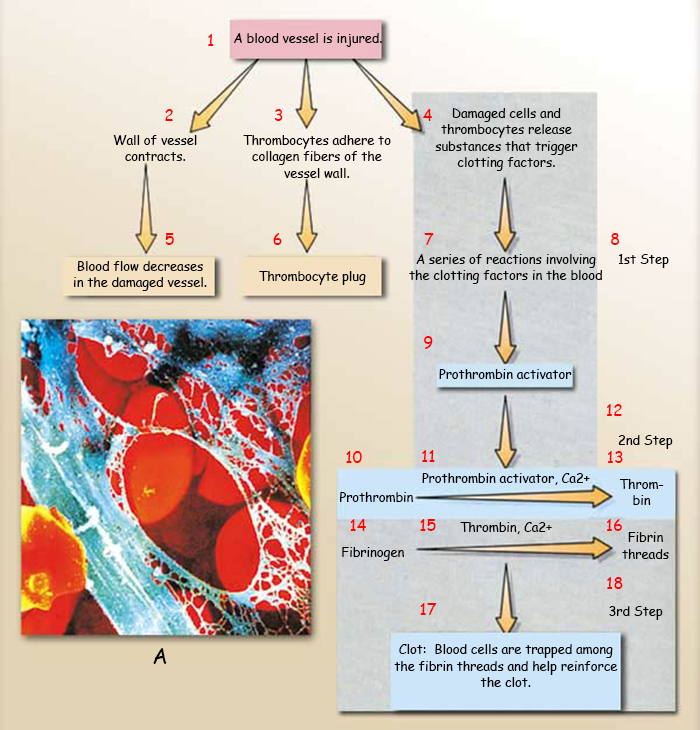 |
1. A blood vessel is injured. |
Clot formation in the injured vessel is a miraculous phenomenon. A great many factors and enzymes are involved in the clotting process, working in a chain. For example, there are 16 different elements producing thrombin alone. For just one of them to be left out of the equation will halt the clotting process. According to the theory of evolution, one of the countless proteins involved must have emerged first, with the others then appearing in sequence over very long periods of time. However, no living thing could afford even a brief waiting period. Such a system can only function when everything exists, fully formed. This shows us that these perfect systems are examples of God's creation. |
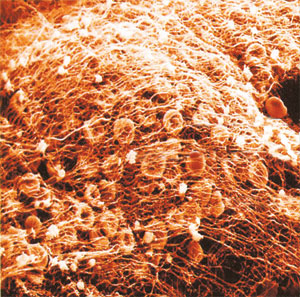 |
It is very important that blood should clot only over the site of the wound. The protein known as antithrombin stops the blood-coagulating proteins one by one, ensuring that the blood clots in the right place and in the right amount. A single hitch in this system will cause blood to coagulate in the vessels, which in turn will lead to death. |
The necessary precautions taken in a single process to protect the body are astonishing. Coagulation is just one feature of the body's defense mechanism. The endeavors of the thousands of cells that go into action to take precautionary measures are truly amazing.
If a clot has formed anywhere on your body, it soon begins puckering. The reason is that the clot starts contracting one or two minutes after it forms, and that the fluid within it departs in 30 to 60 minutes. This puckering does not happen at random, and the coagulation in your body is an example of the perfectly rational precautions taken by the cells.
The cells that go into operation during wound puckering are, again, the thrombocytes. In order for this to take place, thrombocytes release the contractile proteins we have already referred to. The puckering clot pulls together the torn edges of the veins and lets them fuse together again more quickly, assisting with the acceleration of coagulation. When thrombocytes go into action once more, they cling to the connections of the clot fibrins that form so as to reinforce these fibers. At the same time, they fix the diagonal bonds between the fibrins with a substance they release.66
For various reasons, the blood only coagulates over the wound site. When you consider capillaries just nine thousandths of a millimeter thick, you can clearly see that this is the result of perfect organization and fine mathematical calculation, because it is essential for the blood to know where to clot, the needed amount and to stop clotting when coagulation reaches to the adequate level. At this point another protein enters the equation: Antithrombin, which halts all the proteins activated for blood clotting, one by one. Of course, countless enzymes work in order for antithrombin to become involved. These processes will be considered without entering into too much detail.
Everyone knows how sensitive a wound feels when it starts to heal. The slightest impact causes it to open up again and for bleeding to begin again. The body has taken a precaution for this also. A protein known as fibrin stabilizing factor squeezes together the fibrins making up the clot by attaching them tightly to one another. If there were no such reinforcing factor, then the wound would immediately open up again with your ordinary, day-to-day movements, and that region could never heal.
Another measure concerns the removal of the clot. The scab that forms once a wound has healed also has to be broken down again. An enzyme called plasmin assumes this responsibility. Plasmin attacks the fibrins and tears the clot apart by severing them one by one. In fact, plasmin begins doing so from the moment the fibrins first form. In other words, as the fibrins come together to form the clot, the plasmin is busily trying to destroy them. The timing of these two processes has been created with such a perfect equilibrium that while the plasmin is busy attacking the fibrins, the wound heals. The faster the fibrin formation, the slower their removal by the plasmin, so that the two processes finish at exactly the right time.67
 |
Good is my Lord and your Lord so worship Him. This is a straight path. Surah-Maryam: 36 |
Even someone who knows only the broad outlines of this mechanism as described here can comfortably conclude that any event occurring randomly in such a system will inevitably damage it. That being so, evolutionists need to explain how chance came to bring about a protein so important for coagulation and located it in the blood. What random event realized the need to produce another protein in order to set it in motion and accordingly formed an interconnected chain? Which coincidence has taught the protein to come into action when there is an injury to the blood vessel, and which coincidence has stopped the protein's activity when the injury has healed? How could these coincidences occur in a flawless manner, in the same sequence, in millions of people, and how come they never damage this special sequence in the blood-clotting system? Why does thrombin never go into action before accelerin, and why does fibrinogen not spontaneously initiate clot formation? Is it possible for even a single stage of the many interconnected ones that comprise this extraordinary system to come into being by chance?
Not a single enzyme in a single step of this order, with such impressive details and exceedingly sensitive timing and balances, can form by chance, of course. It is Almighty God Who creates the whole system and every detail in that system, Who rules all things, and Who maintains all the functions under His control. God has created all the systems in our bodies with great complexity and perfection. Evidence such as this clearly reveals the invalidity of evolutionist claims regarding chance, and is sufficient to prove the fact of creation. This is a major truth, which Darwinists can clearly see, and which they sometimes even admit. Yet they persist in their denial in the face of all the facts. God reveals in the Qur'an:
Then inquire of them: is it they who are stronger in structure or other things We have created? We created them from sticky clay. No wonder you wonder [at God's creative power as well as at the blind arrogance of those who deny it] as they laugh with scorn! (Surat as-Saffat: 11-12)
What would happen if just one of the interconnected links in the chain of this magnificent system were absent? This is a most important question that totally invalidates all evolutionist claims on the subject. When you remove just a single link in this sequence, the blood will be unable to perform its coagulating function.
What kind of consequences might this have? Under normal conditions, a person would not feel the lack of Stuart factor or some other protein. However, the moment bleeding starts anywhere in the body, that lack will immediately reveal itself, and the consequences may even be fatal. The bleeding that begins may never stop, and even a very small cut may still represent a major problem.
That is, if the bleeding is external. Internally, sudden internal bleeding begins to inflict serious harm on the joints and cartilage, and if the bleeding cannot be halted, then death is inevitable.
The medical condition of hemophilia, which prevents blood coagulation, is the most important example of this, in which one single member of the clotting system in the blood is unable to fulfill its function. The absence of a single factor makes all the others in the entire system redundant and useless. Blood that fails to coagulate will constantly flow from any wound that opens up. Unless external pressure is applied, the wound will never heal. Blood transfusions are generally performed to resolve this problem, or else a coagulating factor is applied directly to the region.68 If the medical interventions in question are not performed, then there is no other way of halting the bleeding.
 |
...Say: Are the blind and seeing equal?Or are darkness and light the sarne?Or have they assigned partners to God who create as He creates so that all creating seems the same to them? ''Say: God is the Creator of everything.He is the One, the Al-Conquering." (Surah-Ra'd:16) |
One proof that the imaginary process of evolution never took place is the perfection and complexity in the clotting system. According to Darwinists, every one of these factors came into being in stages, yet each stage is functionless on its own. The coagulation system can start to function only after the passing of millions of years, when all its elements succeed in coming into being, all by chance. There's absolutely no doubt that no living organism can afford to wait for such a development. This fact alone is sufficient to show that evolution is a completely illusory concept.
Torben Hakier, author of the book Mechanisms in Blood Coagulation, Fibrinolysis and the Complement System, expresses the irreducible complexity in the clotting system:
A system of this kind cannot just be allowed to free-wheel. The success of the coagulation process is due to the finely tuned modulation and regulation of all of the partial proteolytic digestions that occur. Too little or too much activity would be equally damaging for the organism. Regulation is a central issue in blood coagulation.69
Michael Behe, a professor of biochemistry from Lehigh University, describes how not a single link in the clotting chain, and not even a single one of the genes comprising that link, could have come into being by chance, as evolutionists would like us to believe:
So making a new blood-coagulation protein by shuffling is like picking a dozen sentences randomly from an encyclopedia in the hope of making a coherent paragraph.70
The impossibility of such a system coming into being by chance is calculated as follows:
Consider that animals with blood-clotting cascades have roughly 10,000 genes, each of which is divided into an average of three pieces. TPA [a clot-dissolving enzyme] has four different types of domains. By variously shuffling, the odds of getting those four domains together is 30,000 to the fourth power, which is approximately one-tenth to the eighteenth power.71
As Behe states, "no one on earth has the vaguest idea how coagulation cascade came to be."72 The system is too complex and flawless to have come into existence by chance, and is so perfect that it can only be the work of a sublime Creator. To comprehend the existence of the Creator, Whose creative artistry prevails on Earth, is also to understand that an incomparable intelligence also emerges with supreme magnificence in our bodies, in every stage of the systems that are invisible to the naked eye. Anyone capable of reason will have no hesitation over perceiving these facts. The absolute existence of God, in all His glory, is plain for all to see. God describes His flawless act of creation in a verse:
It is He Who created you from earth, then from a drop of sperm, then from an alaq [embryo], then He brings you out as infants, then so you may achieve full strength, then so you may become old men—though some of you may die before that time—so that you may reach a predetermined age and so that hopefully you will use your intellect. (Surah Ghafir: 67)
When Michael Behe first introduced the concept of irreducible complexity, he cited the blood coagulation mechanism as his principal example. From among all the countless examples of irreducible complexity in the body, he selected this system in particular as an example of the superior organization exhibited both separately and together by the components that comprise this system.
Before too long, Behe's statement on the subject of blood clotting attracted considerable reactions from evolutionist circles. The way he described the features of such a complex system, plus his scientific demonstration of the impossibility that these could have evolved independently of one another, presented a major challenge to the theory of evolution. One of the first who lost no time in reacting was Russell Doolittle, a professor of biochemistry at the University of California, San Diego, and a dyed-in-the-wool evolutionist, whose field of expertise in his 35-year academic career is blood coagulation.
Doolittle claimed that in a new laboratory study, he had proved it was possible to remove two compounds in a rat's blood-clotting system. According to him, rats were able to survive without difficulty even in the absence of these two compounds in their coagulation mechanism. In fact, however, the situation was rather different. Doolittle had either misread the results of the study, or else ignored a few important points in order to mislead people. The reference in which the results of the study were published73 clearly stated that these rats suffered severe health problems and had no functional clotting mechanism at all. In other words, contrary to what Doolittle claimed, the rat coagulation system was not reducible.74
 |
He is the Originator of the heavens and theEarth.How could He have a son when He has no wife?He created all things.That is God your Lord.There is no god but him... (Surat-al-An'am: 101-102) |
Doolittle made another claim based on the similarity of the proteins involved in clotting.75 He claimed that the similarity in the amino acid sequences in proteins were the result of their deriving from a common ancestor and suggested that the system could have evolved in this way over millions of years. According to this evolutionist conjecture, the protein sequences contributing to the coagulation processes resemble one another, as well as other proteins not involved in the process. Therefore, these all must come into existence as a result of the same gene being copied. This means that they all must have emerged, allegedly, from a single common forerunner. Proteins formed from copies of this imaginary forerunner were subjected to gradual and minute alterations until they produced all these similar proteins, albeit with very different functions.
To this so-called "greatest claim" put forward about the imaginary evolution of the blood-clotting mechanism, Michael Behe provides the following reply:
With the proteins of blood clotting, however, the task of adding proteins to the cascade appears to be horrendously problematic. With one protein acting on the next, which acts on the next, and so forth, duplicating a given protein doesn't give you a new step in the cascade. Both copies of the duplicated protein will have the same target protein which they activate, and will themselves be activated by the same protein as before. In order to explain how the cascade arose, therefore, a scientist has to propose a detailed route whereby a duplicated protein turns into a new step in the cascade, with a new target, and a new activator. Furthermore, because clotting can easily go awry and cause severe problems when it is uncontrolled, a serious model for the evolution of blood clotting has to include quantitative factors, such as how much of a clot forms, what pressure it can resist, how frequent inappropriate clots would be, and many, many more such questions.
 |
Is then He Who creates like one that creates not? Will ye not receive admonition? If ye would count up the favours of Allah, never would ye be able to number them: for Allah is Oft-Forgiving, Most Merciful. (Surat an-Nahl: 17-18) |
Professor Doolittle has addressed none of these questions. He has confined his work to the question of what proteins appear to be descended from what other proteins, and is content to wave his hands and assert that, well, those systems must have been put together by natural selection somehow. [...] His work concerns sequence comparisons. Doolittle has no idea of whether the clotting cascade could have been built up by natural selection.76
Of course, similarities among proteins constitute no evidence for evolution at all. (For more detail on this subject, see, Harun Yahya, The Evolution Deceit.) Furthermore, the duplicated gene in Doolittle's claim will be identical to the one before it—in other words it will possess the same components as its predecessor. It is impossible to acquire new features simply by duplication.
In order to account for the present existence of proteins with special duties in the blood-clotting system, this scientist has to explain how a duplicated gene came to acquire new and different properties. Yet for Doolittle, with his 35-year career specializing in blood clotting, this remains unanswerable.
Professor Kenneth Miller, a cell biologist from Brown University, falls into the same error as Doolittle. He too has claimed that duplicated genes explain the fictitious evolution of this special system. Miller set this far-from-scientific claim out in a book:
 |
When a blood vessel is damaged (A), certain blood cells begin secreting a number of chemical substances (B), and cause a number of reactions to halt blood flow. One of these reactions forms the protein fibrin, which forms a fibrous mesh to impede the flow of blood (C). |
... One of these duplicate genes was then mistargeted to the bloodstream, where its protein product would have remained inactive until exposed to an activating tissue protease—which would happen only when a blood vessel was broken. From that point on, each and every refinement of this mechanism would be favored by natural selection. Where does the many-layered complexity of the system come from? Again, the answer is gene duplication. Once an extra copy of one of the clotting protease genes becomes available, natural selection will favor slight changes that might make it more likely to activate the existing protease. An extra level of control is thereby added, increasing the sensitivity of the cascade.77
This account provides no information at all as to how the system in question functions. A scientific response to it comes from Michael Behe, who has seen the extraordinary nature of the blood-clotting mechanism and described it in full detail countless times:
Professor Miller simply tries to use the term gene duplication as a magic wand to make the problem go away, but the problem does not go away. Miller's assertion that natural selection would favor each additional step is made quite problematic by the fact that each step in clotting has to be strictly regulated or else it is positively dangerous... Miller's statement does not even say what the newly duplicated proteases are envisioned to be acting on—whether the tissue protease, the original mistargeted circulating protease, plasma proteins, or everything at once.
Such a brief story is of no use at all in understanding how the irreducible complexity of the clotting cascade could be dealt with by natural selection. It strikes me that the main purpose of the paragraph is not to actually contribute to our understanding of how clotting actually may have arisen, but to persuade those who aren't familiar with biochemical complexity to believe Darwinism has the problem under control. It doesn't.78
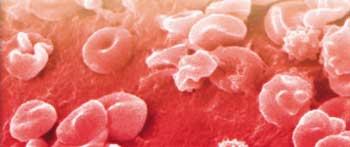 |
As noted by Behe, evolutionists' fictitious accounts, which I have emphasized many times in my other books, may interest people with only a superficial knowledge of the subject. As studies along these lines increase in number, however, and education levels rise, people are discovering ever more details concerning the magnificent order in the universe, and see the truth of creation in perfect clarity. The traditional methods that evolutionists employ will soon be deprived of their present-day so-called validity.
In the face of all these facts—and despite all the scientific proofs of the extraordinarily complex details in the human body and all living things—evolutionists are still hiding behind each others' explanations and seeking a way out for their theory.
Darwinists are waiting for the emergence of a climate that will bring their claims to the fore and hoping for a fault in the sublime order on Earth that will constitute a basis for their claims. As revealed in the verse, however, perfection prevails everywhere they look, for which reason they will never find any deficiency.
Our Almighty Lord, Who has full knowledge of every act of creation, reveals this about those who seek an inconsistency in His creation:
He Who created the seven heavens in layers. You will not find any flaw in the creation of the All-Merciful. Look again—do you see any gaps? Then look again and again. Your sight will return to you dazzled and exhausted! (Surat al-Mulk: 3-4)
 |
Those who remember God,standing sitting and iying on their sides,and reflect on there creation of the Earth:"Our Lord You have not created this for nothing.Glory be to You!So safeguard us from the punishment of the Fire." (Surah Al-Imran:191) |
61 Michael J. Behe, Darwin's Black Box, New York, The Free Press, 1996, pp. 77-78.
62 Textbook of Medical Physiology, p. 77.
63 http://people.a2000.nl/aalan/vucut/bolum4.html, Yusuf Alan, "Saniyeler içinde vucutta olup bitenler," ("The Activities Happening in the Body in a Second")
64 Darwin's Black Box, pp. 81-83.
66 Textbook of Medical Physiology, p. 78.
68 The Human Body: An Intelligent Design, p. 117.
69 http://www.arn.org/docs/behe/mb_indefenseofbloodclottingcascade.htm, Ken Miller and Keith Robison, "In Defense of the Irreducibility of the Blood Clotting Cascade: Response to Russell Doolittle"
73 Bugge et al., "Loss of Fibrinogen Rescues Mice from the Pleiotropic Effects of Plasminogen Deficiency," Cell 87, 1996: pp. 709-719.
74 http://www.arn.org/docs/behe/mb_indefenseofbloodclottingcascade.htm
75 http://bostonreview.mit.edu/br22.1/doolittle.html, Russell F. Doolittle, "A Delicate Balance"
76 http://www.arn.org/docs/behe/mb_brrespbr.htm, Michael J. Behe, Letter to the Boston Review
77 Kenneth R. Miller, Finding Darwin's God, New York: Cliff Street Books, pp. 156-157
78 http://www.arn.org/docs/behe/mb_indefenseofbloodclottingcascade.htm